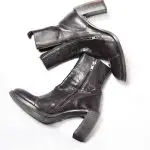Curious about staying cool in the heat? Did you know that polyester can actually be up to 30% cooler than cotton?
In this exploration, we'll dive into the science of fabric cooling to uncover whether polyester truly outperforms cotton. From moisture-wicking properties to breathability, we'll compare the two fabrics to help you make an informed choice.
Whether you're seeking comfort during workouts or looking for everyday wear that keeps you feeling fresh, understanding the cooling capabilities of polyester and cotton will empower you to make the best decision for your needs.
Let's unravel the truth about fabric cooling together.
Key Takeaways
- Polyester efficiently pulls moisture away from the skin and keeps you drier and more comfortable.
- Polyester's moisture-wicking properties help regulate body temperature during physical activity and prevent the build-up of moisture and sweat.
- Polyester outperforms cotton in managing moisture during exercise, prevents chafing and discomfort, and allows for quick evaporation.
- Cotton feels lightweight and breathable, helps regulate body temperature, and provides all-day comfort in various climates.
The Science Behind Fabric Cooling
When it comes to understanding the science behind fabric cooling, it's important to consider how different materials interact with heat and moisture. Fabric technology has seen remarkable advancements, leading to cooling innovation. Fabrics have the ability to impact how your body manages heat, and this is where the science comes into play.
Some fabrics are engineered to wick moisture away from your skin, allowing it to evaporate more quickly. This evaporation process draws heat away from your body, keeping you cooler. Additionally, the structure of the fabric can also play a role in cooling. For example, certain weaves or knits can create more surface area, facilitating better airflow and heat dissipation.
Understanding the science behind fabric cooling involves delving into the intricacies of how different fibers and fabric structures interact with the body's natural cooling mechanisms. It's a fascinating blend of biology, physics, and material science, and it's the key to unlocking the full potential of cooling innovations in the world of textiles.
Moisture-Wicking Properties of Polyester
If you've ever wondered why polyester is often favored for activewear, it's all about its moisture-wicking properties.
When you sweat, polyester fabric efficiently pulls moisture away from your skin, keeping you drier and more comfortable.
This advantage makes it a popular choice for hot climates and intense workouts.
Polyester's Moisture-Wicking Advantage
Polyester's moisture-wicking properties make it a more efficient choice for keeping you dry during physical activity. Unlike cotton, which tends to retain moisture, polyester fabric technology is designed to pull sweat away from the skin to the outer surface of the fabric where it can evaporate more quickly. This means that when you're working out or engaging in sports, polyester can help regulate your body temperature and keep you feeling more comfortable. Take a look at the table below to see the quick comparison between polyester and cotton in terms of moisture-wicking properties.
| Property | Polyester | Cotton |
|---|---|---|
| Moisture-Wicking | Excellent | Poor |
| Breathability | High | Low |
| Quick Drying | Yes | No |
As you can see, the moisture-wicking advantage of polyester makes it a top choice for athletic performance.
Comfort in Hot Climates
To stay comfortable in hot climates, opt for polyester's moisture-wicking properties, which help regulate body temperature and keep you dry during physical activities. Polyester's sweat absorption and quick-drying capabilities make it an excellent choice for hot weather.
The fabric's breathability allows air to circulate, preventing the build-up of moisture and sweat on your skin, which can cause discomfort and chafing. Additionally, polyester's lightweight nature enhances its comfort in hot climates, as it doesn't weigh you down or cling to your body when you perspire.
When choosing clothing for hot weather, prioritize polyester garments to experience the benefits of moisture-wicking and enhanced breathability, ensuring you remain comfortable and dry, even in the most sweltering conditions.
Performance During Workouts
Maximize your workout performance with polyester's superior moisture-wicking properties. When comparing fabric options for workout gear, polyester outperforms cotton in managing moisture during intense exercise. The table below summarizes the key differences in moisture-wicking properties between polyester and cotton, highlighting the benefits of polyester for workout performance.
| Properties | Polyester | Cotton |
|---|---|---|
| Moisture-Wicking | Excellent at wicking away sweat | Absorbs and retains moisture |
| Breathability | Allows for quick evaporation | Slower evaporation, can feel damp |
| Quick Drying | Dries faster due to moisture-wicking | Dries slower due to moisture retention |
Polyester's moisture-wicking capabilities keep you dry and comfortable during workouts, preventing chafing and discomfort. This fabric comparison underscores the advantage of polyester for optimizing your workout experience.
Breathability and Air Circulation in Cotton
You can feel the breathability and air circulation in cotton immediately when you wear it. The natural fibers of cotton allow air to flow through the fabric, making it feel lightweight and breathable. This is due to the way cotton fibers are spun together, creating small gaps in the fabric that allow for air circulation and ventilation, keeping you cool and comfortable in various climates.
When it comes to breathability and air circulation in cotton, consider the following:
- Moisture Absorption: Cotton has the ability to absorb and release moisture quickly, which helps to wick away sweat from your body, allowing for better evaporation and keeping you feeling dry.
- Heat Regulation: The breathable nature of cotton allows for heat to escape from the body, preventing the build-up of humidity between your skin and the fabric, which can lead to discomfort.
- All-Day Comfort: The air circulation in cotton not only helps regulate body temperature but also provides all-day comfort, making it an ideal choice for various activities and climates.
Comfort and Skin Sensation Comparison
When comparing the comfort and skin sensation of polyester to cotton, you'll notice a distinct difference in breathability and air circulation.
Cotton is renowned for its natural softness and skin-friendly properties. Its breathable nature allows for air to flow freely through the fabric, keeping your skin feeling cool and comfortable, making it ideal for hot and humid weather.
Cotton also excels in moisture absorption, drawing sweat away from your skin and allowing it to evaporate quickly, minimizing any clammy or sticky feeling.
On the other hand, while polyester may offer some level of breathability, it generally doesn't match the natural comfort and skin sensation provided by cotton. Polyester fabrics are often less soft and can sometimes cause skin irritation or discomfort, especially for individuals with sensitive skin.
Additionally, polyester isn't as effective at absorbing moisture, which can result in a less comfortable and breathable experience, particularly in warm conditions.
Ultimately, when it comes to comfort and skin sensation, cotton's breathability and fabric softness make it a preferred choice over polyester.
Environmental Impact of Polyester Vs. Cotton
When comparing the environmental impact of polyester and cotton, it's important to consider factors such as water usage, chemical inputs, and recyclability.
Polyester is derived from non-renewable resources and requires significant energy to produce, while cotton cultivation can lead to water scarcity and heavy pesticide use.
However, advancements in sustainable manufacturing and recycling processes are making both polyester and cotton more environmentally friendly options.
Polyester Vs. Cotton: Environmental Impact
The environmental impact of polyester and cotton production significantly influences their sustainability and ecological footprint. When comparing the environmental impact of polyester and cotton, several factors come into play:
- Environmental Impact: Cotton production requires significant water usage and often involves the heavy use of pesticides and fertilizers, which can lead to soil degradation and water pollution. On the other hand, polyester production is energy-intensive and relies on non-renewable resources, contributing to carbon emissions and environmental pollution.
- Ethical Production: Both polyester and cotton production can involve ethical concerns such as fair labor practices, worker safety, and community impact. It's important to consider the human impact associated with the production of these materials.
- Recycling Initiatives and Sustainable Sourcing: Both polyester and cotton can be recycled, but the effectiveness of recycling initiatives and sustainable sourcing practices varies between the two materials. Understanding the availability and efficiency of recycling programs and sustainable sourcing is crucial in assessing their overall environmental impact.
Sustainability: Polyester and Cotton
To compare the environmental impact of polyester and cotton, consider their sustainability and ecological footprint. Cotton sustainability involves the use of significant water, pesticides, and land, impacting the environment. On the other hand, polyester production leads to pollution, primarily through microfiber shedding during washing, contributing to marine pollution. Here's a comparison of the environmental impact of polyester and cotton:
| Environmental Impact | Cotton | Polyester |
|---|---|---|
| Water Usage | High | Low |
| Pesticide Consumption | High | None |
| Land Requirement | Extensive | Minimal |
| Pollution | Low | High |
| Recyclability | Yes | Yes |
Consider these factors when making sustainable choices, as both materials have differing environmental impacts.
Durability and Long-Term Cooling Performance
For long-term cooling performance, you should consider the durability of polyester and cotton fabrics.
Here are some key points to consider when evaluating the durability and long-term cooling performance of polyester and cotton fabrics:
- Polyester Durability: Polyester is known for its long-term durability, making it resistant to shrinking, stretching, and wrinkling. This resilience ensures that the fabric maintains its shape and size over time, contributing to consistent cooling performance. Additionally, polyester's ability to retain its color and strength after repeated washes enhances its long-term cooling properties.
- Cotton Durability: While cotton is a natural fiber with good initial strength and durability, it's more prone to shrinking and wrinkling compared to polyester. However, cotton's breathability and moisture-wicking properties contribute to its long-term cooling performance, especially in hot and humid conditions. Proper care, such as avoiding high heat when drying, can help maintain cotton's cooling properties over time.
- Thermal Regulation: Both polyester and cotton offer thermal regulation, but their mechanisms differ. Polyester's moisture-wicking properties and quick drying time contribute to its long-term cooling performance, while cotton's absorbency and breathability play a key role in regulating body temperature over time.
Understanding the nuances of these fabrics' durability and cooling properties can help you make an informed choice based on your specific needs.
Maintenance and Care for Cooling Fabrics
Keep polyester and cotton fabrics cool and comfortable with proper maintenance and care. When it comes to fabric care, washing is a crucial aspect. For both polyester and cotton, using a mild detergent and cold water is ideal to maintain the cooling properties. Avoid using bleach as it can damage the fabric and reduce its cooling effect. Additionally, it's important to wash these fabrics with similar colors to prevent any potential color bleeding.
In terms of drying, polyester and cotton fabrics are best air-dried to maintain their cooling properties. If using a dryer, opt for a low heat setting to prevent any heat damage. Ironing these fabrics should be done at a low temperature. For polyester, using a pressing cloth is advisable to prevent direct contact with the iron. Cotton, on the other hand, may require slightly higher ironing temperatures, but it's important to avoid high heat that can compromise its cooling abilities.
Practical Considerations for Different Activities
Ensure that you choose the appropriate fabric based on the activity you'll be engaging in, as this can significantly impact your comfort and performance. When it comes to outdoor activities in hot weather, your clothing choices play a crucial role. Here are some practical considerations for different activities:
- Moisture Wicking: For high-intensity outdoor activities like running or hiking, polyester is an excellent choice due to its moisture-wicking properties. It draws sweat away from your skin, keeping you dry and comfortable even in the heat.
- Breathability: If you're engaging in activities that require a wide range of motion such as yoga or Pilates, cotton can be a good option. It allows for better air circulation and breathability, making it ideal for low to moderate intensity workouts.
- Quick Drying: When engaging in water-based activities like kayaking or paddleboarding, polyester fabrics are preferable as they dry quickly, preventing discomfort and chafing.
Selecting the right fabric for your activities can make a significant difference in your overall experience, ensuring that you stay cool, comfortable, and able to perform at your best.
Frequently Asked Questions
Can Polyester Fabric Be as Soft and Comfortable as Cotton?
Polyester fabric can be as soft and comfortable as cotton, while also offering better breathability and moisture-wicking performance. Its advanced technology provides a balance of comfort and functionality, making it a versatile choice for various activities.
Are There Any Health Concerns Associated With Wearing Polyester Fabric in Hot Temperatures?
Wearing polyester fabric in hot temperatures may raise health concerns due to its lower breathability and sweat absorption compared to cotton. Be mindful of potential discomfort and irritation, and opt for breathable fabrics.
How Does the Cost of Polyester Compared to Cotton in Terms of Cooling Performance and Durability?
When comparing polyester and cotton, consider cost, durability, and performance. Polyester may be more affordable and durable, but cotton's natural breathability and cooling properties make it a top choice for many.
Can Cotton and Polyester Fabrics Be Blended to Create a Fabric That Combines the Cooling Benefits of Both Materials?
You can create cotton-polyester blends to combine the moisture-wicking properties of polyester with the breathability of cotton, providing excellent thermal regulation. This makes the fabric ideal for outdoor activities and enhances athletic performance.
Are There Any Specific Activities or Sports Where Polyester Would Be a Better Choice for Cooling Than Cotton?
For outdoor activities and sports, polyester can offer better cooling performance than cotton due to its moisture-wicking properties. A fabric blend of polyester and cotton can provide a balance of material comfort for various activities.
- The Pros and Cons of Nonwoven Fabrics: A Balanced View - July 11, 2025
- Nonwoven Fabric 101: Everything a Beginner Needs to Know - July 11, 2025
- Why Is Nonwoven Fabric so Versatile? - July 11, 2025







